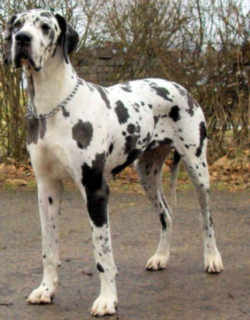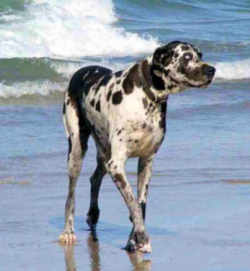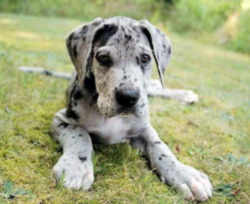Pennsylvania State Dog
Great Dane

(C. l. familiaris)
Adopted on August 17, 1965.
The Great Dane, (Canis familiaris,) was adopted as the state dog for Pennsylvania. The next time you visit the Governor's Reception Room in Harrisburg, look for a portrait of William Penn with his Great Dane. Now a popular pet, the Great Dane was a hunting and working breed in frontier Pennsylvania. The choice of State Dog is also unique for the vote that approved it. When the Speaker of the House called for a voice vote to designate the Great Dane, yips, growls and barks assaulted his ears from every part of the chamber! With a rap of his gavel, the Speaker confirmed that the "arfs have it" and the "Barking Dog Vote" entered the annals of legislative history.
The Great Dane is a German breed of domestic dog known for its giant size. The name of the breed in Germany is Deutsche Dogge. They are known for their enormous bodies and great height.
Pennsylvania State Dog: Great Dane

The noble general appearance of the Great Dane combines a tall, strong, well made body with pride, strength and elegance. Through substance paired with nobility, balance, well proportioned outline as well as a specially expressive head, the Great Dane strikes the onlooker as a noble statue. It is one of the giant working breeds, but is unique in that its general conformation must be so well balanced that it never appears clumsy, and shall move with a long reach and powerful drive. He is the Apollo amongst all dog breeds. A Great Dane is spirited, courageous, never timid; always friendly and dependable. Great Danes are easygoing dogs, affectionate with family members and self-confident with strangers. This physical and mental combination is the characteristic which gives the Great Dane the majesty possessed by no other breed. It is particularly true of this breed that there is an impression of great masculinity in males, as compared to an impression of femininity in females.
Owning
Great Danes can make great family dogs but require a lot of companionship and attention. They are good with children but their great size makes them more suitable for older children and teenagers. Great Danes are easily trained but need consistency.
Characteristics

The male appear more massive throughout than the female, with larger frame and heavier bone. In the ratio between length and height, the Great Dane should be square. In females, a somewhat longer body is permissible, providing she is well proportioned to her height. Coarseness or lack of substance are equally undesirable. The male shall not be less than 30 inches at the shoulders, but it is preferable that he be 32 inches or more, providing he is well proportioned to his height. The female shall not be less than 28 inches at the shoulders, but it is preferable that she be 30 inches or more, providing she is well proportioned to her height.
Temperament
The Great Dane is spirited, courageous, always friendly and dependable, and never timid or aggressive, but reserved towards strangers. He has a high resistance to any provocation and not aggressive.
History
The ancestors of the Great Dane include British mastiffs and possibly wolfhounds, brought to Europe, first by the Romans and later by German aristocrats seeking to improve their hunting dogs. Despite its name, the Great Dane is a German breed. The Great Dane was developed in Germany to hunt wild boars. The earliest written description of a dog resembling the breed may be found in Chinese literature of 1121 B.C. (an article by Dr. G. Ciaburri, Great Dane Club of Italy publication, 1929). According to W. Nouc the name 'Great Dane' goes back to the French natural scientist Buffon (1707-1788). He coined the term because at that time especially strong dogs were being bred in Denmark. The name of the breed (in the English language) is a translation of an old French designation, grand Danois, meaning "big Danish." This was only one of half a dozen names which had been used for centuries in France. Why the English adopted the name "Great Dane" from the French is a mystery. The new term 'Deutsche Dogge' was established at a judges' assembly in Berlin in1880. Eight years later the 'Deutsche Doggen Club' was founded (today called 'DDC 1888'). In 1891 the Great Dane Club of Germany adopted a precise standard, or official ideal specimen. For more than 100 years the term `Great Dane' has been used for Deutsche Dogge , especially at international dog shows. For this reason it is often assumed that Deutsche Doggen and Great Danes are two different breeds.
Pennsylvania Law
The law designating the Great Dane as the official Pennsylvania state dog is found in The Pennsylvania Statutes, Title 71, Chapter 6, Section 1008.
Title 71 P.S. State Government
I. The Administrative Codes and Related Provisions
Chapter 6. Provisions Similar or Closely Related to Provisions of the Administrative Code
Secretary and Department of Internal Affairs
State Emblems
§ 1008. State dog
The Great Dane is hereby selected, designated and adopted as the official dog of the Commonwealth of Pennsylvania.
CREDIT(S)
1965, Aug. 17, P.L. 331, § 1.
HISTORICAL AND STATUTORY NOTES
1990 Main Volume
Preamble:
This act contained the following preamble:
"Whereas, the dog has faithfully and voluntarily performed invaluable physical, psychological and economic service to mankind as guardian of home
and industry, companion to youth and aged, hunter, herder, hauler, guide to the blind and indispensable aid to our armed forces of the battlefront
until he is today known as "Man's Best Friend"; and
"Whereas, the Great Dane is prominently depicted in the Governor's reception room painting by Pennsylvania artist Violet Oakley as the "Best
Friend" of the founder of this Commonwealth, William Penn; and
"Whereas, the Great Dane came from England just as did William Penn and later was further developed by Germany just as was Pennsylvania by the "Pennsylvania
Dutch"; and
"Whereas, the Great Dane has held a consistent and honored position in many other foreign countries as well as throughout the United States, thereby
further typifying the varied peoples who have contributed to the greatness of this Commonwealth and Nation; and
"Whereas, the Great Dane represents both the great hunting and industrial parts of Pennsylvania, having begun as a hunting breed just as Pennsylvania
began as a hunting Commonwealth, later also becoming a leading working breed, just as Pennsylvania became a leading working Commonwealth; and
"Whereas, the outline of the Great Dane's head resembles the outline of the Commonwealth's Boundaries; and
"Whereas, the Great Dane is known as the King of his species, just as Pennsylvania's State Bird is known as the King of its species; and
"Whereas, the physical and other attributes of the Great Dane, to wit: size, strength, beauty, intelligence, tolerance, courage, faithfulness, trustworthiness
and stability exemplify those of Pennsylvania; and
"Whereas, naming an official dog of the Commonwealth would recognize the steadfast service and loyal devotion of all dogs in Pennsylvania and provide
a symbol of the great Home side of Pennsylvania; and
"Whereas, naming the Great Dane would pay tribute to internationally known Pennsylvania artist, Violet Oakley, for her historic works which beautify
the entire Capitol."
Title of Act:
An Act selecting, designating and adopting the Great Dane as the official dog of the Commonwealth of Pennsylvania. 1965, Aug. 17, P.L. 331.
71 P.S. § 1008, PA ST 71 P.S. § 1008
Taxonomic Hierarchy: Great Dane
Kingdom: Animalia
Phylum: Chordata
Class: Mammalia
Order: Carnivora
Family: Canidae
Genus: Canis
Species: C. lupus
Subspecies:








